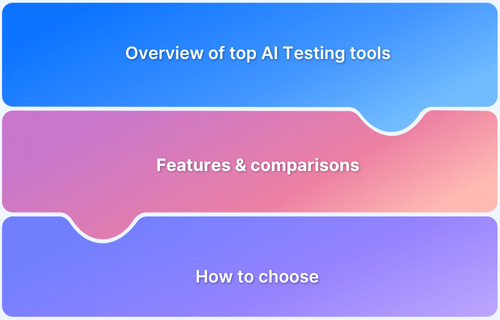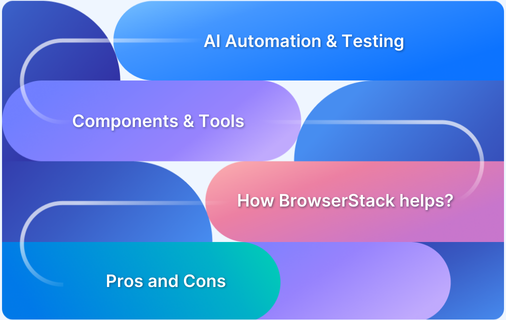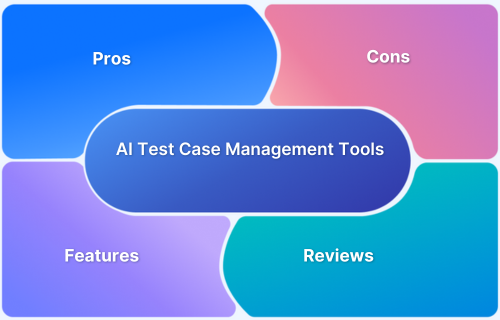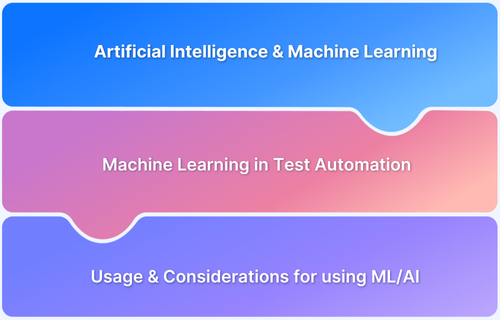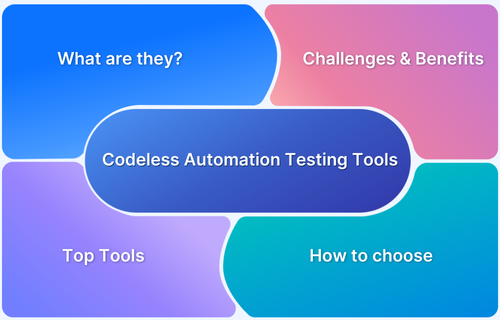Generative AI is changing the way teams approach software testing by automating test creation, adapting to changes, and generating realistic data.
Overview
Generative AI testing uses AI models to automatically create test cases, scripts, and synthetic data, while adapting tests to changes in real time. It shifts QA from manual design to intelligent, self-optimizing workflows.
Best Generative AI Testing Tools
- BrowserStack Generative AI & AI Agents: A platform that delivers codeless test creation, self-healing automation, and smart test optimization across 20,000+ real devices and browsers.
- Testsigma Atto: An AI-powered assistant that generates, adapts, and executes tests seamlessly, helping teams accelerate regression and functional testing.
- Functionize: A cloud-based tool that converts plain English descriptions into executable tests while adapting dynamically to application changes.
- TestRigor: A no-code platform where tests are written in natural language, with AI maintaining and updating them as applications evolve.
- Katalon Studio AI: A testing suite that integrates AI for self-healing scripts, automated test generation, and intelligent test analytics.
- Virtuoso: A test automation solution focused on self-healing and AI-driven functional testing, built for agile and continuous delivery environments.
- Applitools Visual AI: A visual testing tool that uses AI to detect meaningful UI changes, filtering out pixel-level noise to ensure consistency.
- Datacebo / Tonic.ai: Platforms that specialize in generating synthetic test data, ensuring privacy compliance while covering diverse scenarios.
- Testim (by Tricentis): A test automation tool that leverages AI for fast authoring, adaptive maintenance, and predictive defect detection.
- QA Wolf: A managed testing service that combines human expertise with AI-driven test generation to provide end-to-end test coverage.
This article explores the growing role of generative AI in software testing, highlights the best tools available.
What is Generative AI Testing?
Generative AI testing refers to the use of artificial intelligence models capable of creating new test assets automatically, including test cases, scripts, data, and even environment setups.
Unlike traditional test automation, which relies on predefined scripts and repetitive execution, generative AI brings adaptability and intelligence into the testing process.
By learning from requirements, source code, user stories, and historical defects, generative AI can produce context-aware tests that evolve alongside the application.
For example, it can generate functional and regression test cases, create synthetic datasets that mirror real-world usage, or update test scripts automatically when UI elements change.
This approach reduces manual effort, broadens coverage, and ensures more resilient quality assurance pipelines. In short, generative AI transforms testing from a reactive, scripted task into a proactive, intelligent process that continuously optimizes itself as software evolves.
Best Generative AI Testing Tools
To put generative AI into practice, several tools have emerged that help teams automate test creation, reduce maintenance, and scale QA efficiently.
BrowserStack Generative AI & AI Agents
BrowserStack brings the power of Generative AI directly into the testing lifecycle, enabling teams to create, adapt, and run tests with minimal manual effort. Its AI-driven agents cover the entire QA spectrum, test generation, self-healing, optimization, accessibility, and visual testing, ensuring faster feedback and resilient automation at scale.
Key Features:
- Codeless, AI-driven test case generation and low-code authoring.
- Self-healing tests that adapt to UI and workflow changes automatically.
- Smart test selection and deduplication to optimize regression cycles.
- Accessibility (A11y) issue detection and AI-powered visual reviews.
- Scalable execution across 20,000+ real devices and browsers in the cloud.
Pros:
- End-to-end AI coverage across functional, regression, accessibility, and visual testing.
- Reduces test creation time and minimizes maintenance overhead.
- Enterprise-grade scalability, reliability, and security.
- Speeds up CI/CD pipelines with optimized, intelligent test runs.
Testsigma Atto
Designed as an AI-powered assistant, this tool streamlines regression and functional testing by generating test cases from natural language and adapting them automatically as applications evolve. It helps teams accelerate QA cycles while reducing maintenance overhead.
Features:
- Natural language test creation
- Auto-generated regression and functional cases
- Self-healing test execution
- Cloud execution with CI/CD integration
Pros:
- Easy for non-technical users to get started
- Cuts regression testing time significantly
- Works well within agile workflows
Cons:
- Limited flexibility for highly customized tests
- Cloud-first model may not suit all teams
- Some advanced features require premium tiers
Functionize
Built as a cloud-native testing platform, this tool uses natural language processing and machine learning to turn plain English descriptions into executable tests. It adapts automatically to application changes, reducing flakiness and making it easier for teams to maintain test suites over time.
Features:
- Natural language (NLP) test authoring
- Self-healing automation for evolving apps
- Cloud-based execution at scale
- Smart dashboards and analytics
Pros:
- Very low learning curve with English inputs
- Scales well across browsers and devices
- Provides strong analytics and reporting
Cons:
- On-premise support is limited
- Lock-in to proprietary ecosystem
- May struggle with highly domain-specific logic
Read More: Functionize Alternatives
TestRigor
Focused on no-code automation, this platform allows teams to author tests entirely in plain English. Its AI continuously maintains and updates test suites as applications change, significantly cutting down on manual upkeep and making it ideal for agile environments.
Features:
- Plain English test authoring
- End-to-end web and mobile automation
- Self-healing test execution
- Seamless CI/CD integration
Pros:
- Very accessible for non-technical testers
- Highly adaptive to UI and workflow changes
- Fits well into agile and DevOps pipelines
Cons:
- Limited customization for complex technical cases
- Additional setup needed for advanced API testing
- Can run slower than some rivals for large suites
Also Read:testRigor Alternatives
Katalon Studio AI
As an extension of the popular Katalon Studio platform, the AI-powered version enhances automation with smart self-healing, test generation, and analytics. It’s designed for teams that want an all-in-one solution to cover web, mobile, API, and desktop testing with intelligent assistance.
Features:
- AI-driven self-healing test scripts
- Automated test generation from requirements
- Advanced analytics and reporting
- Cross-platform coverage (web, mobile, API, desktop)
Pros:
- Rich feature set in a single ecosystem
- Affordable entry point with scalable options
- Strong community and integration support
Cons:
- Can overwhelm beginners with feature depth
- Requires setup and configuration for best results
- AI capabilities are still maturing compared to newer players
Read More:Katalon Alternatives
Virtuoso
Built for agile and DevOps environments, this platform emphasizes continuous testing with AI-driven functional and regression automation. Its natural language authoring and self-healing capabilities make it easier to keep pace with frequent releases and evolving user interfaces.
Features:
- Natural language test creation
- AI-powered self-healing regression tests
- Smart UI recognition
- Continuous testing with CI/CD integration
Pros:
- Well-suited for agile and DevOps workflows
- Reduces test flakiness with adaptive execution
- Offers low-code and no-code flexibility
Cons:
- Smaller user community compared to bigger tools
- Complex scenarios may still require coding
- Pricing can be a hurdle for smaller teams
Read More:Virtuoso QA Alternatives
Applitools Visual AI
Specialized in visual regression testing, this tool uses AI to detect meaningful UI changes across browsers and devices while filtering out pixel-level noise. It helps teams ensure design consistency and user experience without being overwhelmed by false positives.
Features:
- AI-powered visual comparison engine
- Cross-browser and cross-device validation
- Baseline management with automated updates
- Integrations with major test automation frameworks
Pros:
- Best-in-class for visual validation
- Significantly reduces false positives
- Seamlessly integrates with existing test suites
Cons:
- Limited to visual/UI testing, not functional coverage
- Needs fine-tuning for highly dynamic content
- Pricing can scale up for enterprise-level use
Datacebo / Tonic.ai
Focused on synthetic data generation, these tools help QA teams create realistic, privacy-compliant datasets for testing. By mimicking production data while protecting sensitive information, they enable broader scenario coverage and reduce reliance on live environments.
Features:
- AI-driven synthetic data generation
- Privacy-preserving data anonymization
- Edge-case and negative scenario creation
- API-based integration with test pipelines
Pros:
- Ensures compliance for regulated industries
- Produces realistic datasets for better test reliability
- Saves significant time in manual test data preparation
Cons:
- Narrow scope; focused only on data, not test automation
- Requires pairing with other tools for end-to-end testing
- Complex configurations may need data engineering expertise
Read More: Machine Learning for Automation Testing
Testim (by Tricentis
Designed to speed up test creation and maintenance, this tool leverages AI-powered smart locators and self-healing capabilities. It also integrates predictive analytics to detect potential defects early, helping QA teams stabilize tests in dynamic environments.
Features:
- AI-based smart element locators
- Self-healing test automation
- Visual editor for quick test authoring
- Predictive analytics for defect detection
Pros:
- Fast test creation with AI assistance
- Stable tests even in frequently changing apps
- Strong CI/CD integration support
Cons:
- Visual editor may feel restrictive for advanced coders
- Higher pricing compared to some alternatives
- Heavily tied to the Tricentis ecosystem
Read More:Testim Alternatives
QA Wolf
Offered as a managed testing service, this platform blends human QA expertise with AI-driven automation to deliver full test coverage. It’s designed for fast-moving teams that prefer outsourcing test creation and execution while still benefiting from intelligent automation.
Features:
- Managed QA service with AI-powered automation
- End-to-end test coverage for web apps
- Cloud-based test execution at scale
- Collaborative dashboards and reporting
Pros:
- Offloads QA workload from internal teams
- Combines AI efficiency with human oversight
- Rapid onboarding and scaling for startups and growing teams
Cons:
- Less control compared to in-house QA automation
- Ongoing service costs may become high long term
- Limited customization tied to provider’s model and workflow
Key Features to Look for in AI Testing Tools
When evaluating AI-powered testing platforms, teams should focus on capabilities that balance speed, adaptability, and reliability. Some of the most important features include:
- Natural Language Test Creation: Ability to generate tests from plain English or requirements, lowering the entry barrier for non-technical users.
- Self-Healing Automation: Automatic adaptation of test scripts when UI elements, workflows, or APIs change, reducing flaky test failures.
- Synthetic Data Generation: Tools that can produce realistic, privacy-compliant datasets to cover diverse scenarios without exposing sensitive production data.
- Visual & Accessibility Validation: AI-driven checks that detect meaningful UI regressions and accessibility issues while filtering out irrelevant noise.
- Test Optimization (Selection & Deduplication): Intelligence to run only the most relevant tests and eliminate redundant ones, ensuring lean and efficient test suites.
- Seamless CI/CD Integration: Smooth alignment with development pipelines so tests run automatically with every release.
- Scalability Across Devices & Browsers: Cloud-based execution that supports parallel runs on thousands of real devices and environments.
- Advanced Analytics & Insights: AI-powered dashboards that identify trends, high-risk areas, and bottlenecks to guide smarter decision-making.
Read More: Top 20 AI Testing and Debugging Tools
Why Choose BrowserStack AI?
Generative AI is redefining software testing by creating test cases, scripts, and data automatically, while adapting to changes in real time.
BrowserStack extends these capabilities further by combining Generative AI-powered test creation with a suite of specialized AI Agents that optimize every stage of the QA lifecycle.
- Test Case Generator Agent: Creates automated test cases directly from requirements or user flows, reducing design time and boosting coverage.
- Self-Healing Agent: Detects UI or workflow changes and updates tests automatically, preventing flakiness.
- Low-Code Authoring Agent: Allows teams to create and edit tests with minimal coding, enabling non-technical users to contribute to QA.
- Test Selection Agent: Chooses the most relevant tests to run based on code changes, accelerating regression cycles.
- Test Deduplication Agent: Identifies and eliminates redundant test cases, keeping test suites lean and efficient.
- A11y Issue Detection Agent: Detects accessibility issues early, helping teams comply with WCAG guidelines and deliver inclusive apps.
- Visual Review Agent: Highlights meaningful UI changes while filtering out noise, making visual regression reviews faster and more reliable.
With Generative AI plus BrowserStack AI Agents, teams get an end-to-end intelligent testing ecosystem, from automated test generation to adaptive execution, optimization, accessibility validation, and visual assurance.
Conclusion
Generative AI is transforming software testing from a manual, script-heavy process into an intelligent, adaptive workflow that accelerates releases and improves quality. By generating test cases, creating synthetic data, and enabling self-healing automation, it helps QA teams stay ahead of rapid development cycles.
Among the many tools available, BrowserStack stands out by combining generative AI capabilities with a suite of powerful AI Agents, covering functional, regression, accessibility, and visual testing. This end-to-end approach not only reduces test creation and maintenance but also ensures reliability at scale across thousands of real devices and browsers.
For teams looking to future-proof their QA strategy, adopting BrowserStack AI provides a clear path toward smarter, faster, and more resilient testing.



